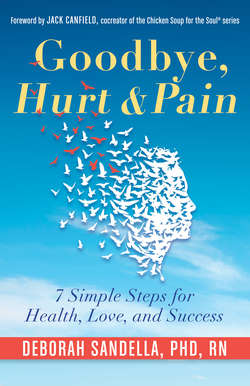Читать книгу Goodbye, Hurt & Pain - Deborah Sandella - Страница 9
На сайте Литреса книга снята с продажи.
INTRODUCTION
ОглавлениеThe phone rings, and I sleepily pick up the receiver. It feels like a dream as I hear my brother's heavy words: “Dad's suffered a cardiac arrest and he's in the ICU.” He has received every possible drug, but his blood pressure isn't holding. The nurses feel sure he can't survive the night, so they have requested a “do not resuscitate” agreement.
In my mind, I hear myself reacting to the nurses: “How can you even ask that question? You have no idea who this man is, how special he is to his whole community.” In this moment, something snaps, and I say, “No, I won't agree.” Having started my career as a nurse, my response is completely out of character, but an intuitive process is taking over.
As I walk back to bed, I am visited by a spontaneous vision. I see my dad with his back to me as he walks off toward the horizon. I am there angrily yelling: “I'm so mad at you for leaving. I'm not ready for you to go. I have so many more things I want us to share.” To my complete surprise, he pauses and turns to face me. His countenance is radiant with a gentle expression I have never seen before when he says in a kind voice: “I didn't know you felt that way; okay.”
As my body senses his words, the anger instantly drains away, and I feel like a wet noodle. At the same time, my logical mind remarks with a statement and question: “All this is just in my head, right?” As I climb back into bed, I feel an urging to keep his image in my awareness, like an earthly lifeline to his spirit.
The next day I fly to rural Kansas and walk into ICU. The nursing staff report: “Sometime in the middle of the night, your dad's blood pressure began to hold.” Encouraged, I sit at his bedside over several nights. I am compelled to imagine the inside of his unconscious body. His lungs appear foggy gray with darker, heavy guck at the bottom. Feeling I would do anything to help him survive, I shed my professional academic image and begin to experiment. Initially, I imagine him breathing in clean, fresh air and exhaling gray darkness. This seems to lighten it a bit, but I can tell it is fatiguing him so I stop.
Next I begin breathing for him. I imagine fresh air filling his lungs, displacing the heavy grayness, which is displaced with each exhale. I become the “breather” as he lies relaxed and unconscious in his hospital bed. Gradually, in my mind's eye I see his lungs fill with bright, blue sky and the grayness is gone except for a solid black spot at the base of his lungs. No matter how hard I try, it remains.
The next morning, the pulmonologist visits and says Dad's lungs actually look good, except for a bit of aspirated solid material at the base. Fortunately, the doctor can mechanically remove the material with a bronchoscope. Although Dad's oxygen levels return to normal after the procedure, the doctor cautions us against false optimism: “I wouldn't get your hopes up. Your dad's brain was without oxygen for a long time, and he's probably suffered brain damage.” Ignoring his caution, I feel encouraged that my intuitive sensing has been accurate, and I begin imagining Dad's vital brain.
The epilogue to my dad's story is that he did survive and, to the complete surprise of the hospital staff, returned with normal mental capacity. He lived five more vibrant years—a time he and my mom said was the best of their lives. We had a second chance and we took it. The results were extraordinary.1
As a doctoral-level health care professional who had done research and taught at the University of Colorado, I could not make sense of this experience. It just didn't compute; it defied everything I had learned about medicine. Yet these imagined experiences were more important to me than all of my numerous years of education, and I committed to understanding how to harness this remarkable power for intentional emotional and physical healing.
Twenty years later, I've learned that imagination is an extraordinary resource within each of us with powers not found in our ordinary thought processes. It is our birthright and so simple that we tend to dismiss it too easily—as if it were child's play. Yet, the extraordinary emotional and physical results I have witnessed speak for themselves. The RIM Method and this book are the culmination of this journey.
